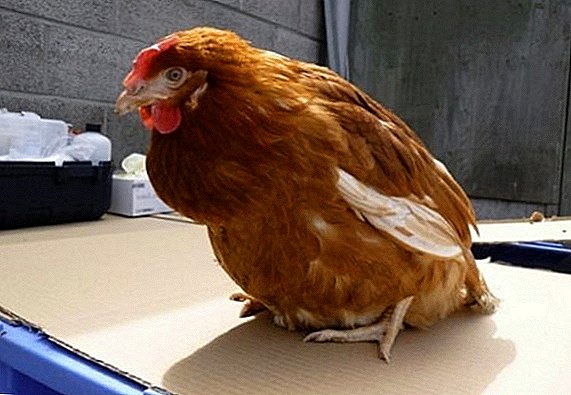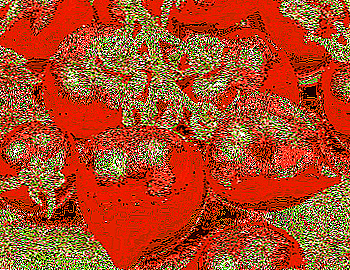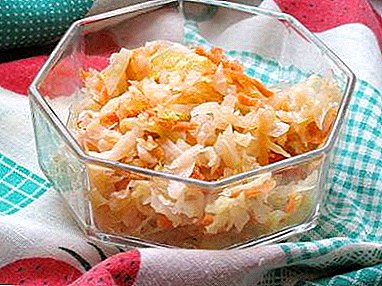
Eye diseases are a fairly common occurrence among chickens.
Moreover, these diseases can have a variety of causes and patterns of manifestation; therefore, it is important for the poultry farmer to be able to distinguish the symptoms of a particular disease, and take appropriate measures in a timely manner. Let us consider in more detail in our article the types, symptoms and methods of treatment of these diseases of chickens.
Possible Ailments: Symptoms, Causes, and Treatment
In chickens, the following are the most common eye diseases.
Tumor

Tumor - manifested as a growth on the eyewhich can have the most different size and a form.
Often, chickens can form a tumor due to swelling or swelling of the eye.
To date, the exact cause of the tumor has not been identified, but it was noticed that it often appears after the birds eat the worms.
Symptoms:
- sore eyes red;
- swelling and swelling observed;
- tumor formation (usually on the lower eyelid);
- tearing eyes;
- decreased vision in chickens.
Treatment
Consider how the treatment takes place. In case of occurrence of this eye disease, first of all, it is recommended to consult a veterinarian, since often surgery requires surgery.
In the case of surgery, the tumor is removed from the eye, and then it is carefully treated with silver nitrate. Further Chicken eyes should be regularly treated with boric acid.
Note! If the tumor is detected at the initial stage, then it is enough to give the chicken food that is saturated with vitamins D and A.
Conjunctivitis

Conjunctivitis - inflammation of the mucous membrane of the eye (conjunctiva). It requires surgical treatment, since the consequences can be very different.
The reasons:
- eye injury;
- exposure to acrid smoke, dust, wind;
- improper content (rare airing, dampness, etc.);
- lack of vitamins;
- exposure to infectious diseases.
Symptoms:
- eye inflammation (redness);
- the appearance of edema;
- severe itching;
- accumulation of pus in the eye;
- tearing;
- lethargy, weakness;
- the occurrence of panophthalmitis, characterized by complete destruction of the sore eye (in especially neglected cases).
Treatment
Mild conjunctivitis is very easy to cure by regular washing of the sore eye with tea or eye drops. For example, for washing you can use boric acid, a solution of vitamin A, chamomile decoction. You can also smear the affected eye with tetracycline ointment.
If the disease is more severe, the bird gets sick, closes its eyes, sits still, it is strongly recommended to completely isolate the sick chicken from the rest of the herd.
Xerophthalmia

Xerophthalmia - This disease is a consequence of beriberi. A characteristic feature is a violation of the mucous and dry eyes. Xerophthalmia has very specific signs, so it is easy to recognize.
The reasons:
- lack of vitamin A in the chicken;
- poor nutrition.
Symptoms:
- the cornea of the eye dries out completely;
- disruption of the sebaceous glands;
- swelling of the eyes.
Treatment
Xerophthalmia is very easy to treat. As a rule, it is only necessary to provide the sick bird with a sufficient amount of vitamin A, which is added to the feed.
Trauma or loss of a century

Trauma or loss of the century - may occur in the process of walking or due to a fight with another bird. Despite the fact that this is not a disease, the poultry farmer should still carefully examine the birds for injuries and promptly treat wounds.
Symptoms:
- swelling of the eyes;
- tearing is observed;
- redness of the century;
- open wound on the eye;
- third eyelid may fall out.
Treatment
The damaged eye must be washed with boric acid. or chlorhexidine. You can also use eye drops (special preference should be given drops with a vitamin A content).
If a foreign object gets into the eye, it should be carefully removed with a pair of tweezers and also treated with one of the means indicated above.
Salmonellosis

Salmonellosis - this disease is typical for young individuals. Salmonellosis is a highly contagious disease, and can be transmitted through chicken eggs.
ATTENTION. This disease can also be transmitted to humans.
You should know that salmonellosis is an infectious disease to which birds with weak immunity are most susceptible.
Symptoms:
- eye redness;
- the appearance of swelling;
- hoarse breathing;
- developing lameness.
Treatment
It is recommended to immediately contact your veterinarian. As a rule, the treatment lasts 10 days and consists of the use of antibiotics (for example, Streptomycin).
Marek's disease - the disease is viral, affecting chickens organs of vision and nervous system. The sick bird should be immediately isolated from the rest.
Symptoms:
- constricted pupil;
- in some cases, blindness may occur.
Treatment
At present, there is no effective cure for Marek's disease, so the sick bird should be killed immediately.
Mycoplasmosis

Mycoplasmosis is a very common disease in chickens. It is found in both young and adult birds.
Cause: Mycoplasmosis is a consequence of a cold disease.
Symptoms:
- the occurrence of inflammation in the eye;
- redness is noted;
- runny nose;
- pathological breathing.
Treatment
It is recommended to immediately contact a specialist who can accurately establish the disease and prescribe an effective treatment. As a rule, antibiotics are used to treat mycoplasmosis in chickens (for example, Farmazin, Tilazin, Pneumotil, etc.).
The antibiotic is added to water calculated for consumption by chickens during the day. The course of treatment is about 5 days. Also It is recommended to prevent this disease.. For this, antibiotics are given within 3 days.
In especially severe cases, the bird should be slaughtered.
Laryngotracheitis

Laryngotracheitis - is a very common viral disease of chickens.affecting the larynx, trachea, nasal cavity, as well as conjunctiva of the eyes (less common).
Causes:
- weak immunity;
- high humidity, dust;
- lack or poor ventilation;
- substandard food.
IMPORTANT. Chickens infect each other with laryngotracheitis "from beak to beak". At the same time, the bird that suffered this disease acquires a very stable immunity, but remains a carrier of the virus throughout its life.
Symptoms:
- tearing eyes;
- decreased appetite;
- lethargy;
- the bird has eyes closed.
Treatment
It is important to start treatment of laryngotracheitis in chicken as soon as possible. For this, antibiotics are commonly used. The use of Biomitsin and Streptomycin in combination with Trivit and Furozolidone will give a good effect.
Also, special attention should be paid to the diet of sick chicken. Vitamin A and E should be added to food.
Preventive measures
It is important to understand that in most cases, avoiding the occurrence of eye diseases in chickens helps to comply with all necessary preventive measures. We list the most common preventive measures:
- periodically inspect birds for eye inflammation, tearing and other behavioral changes;
- create proper conditions for chickens;
- clean the coop regularly and disinfect;
- provide birds with a balanced diet, rich in all essential trace elements and vitamins;
- to vaccinate young (as recommended by the veterinarian);
- timely isolate sick individuals from the rest of the herd.
Thus, the slightest change in the condition and behavior of chickens should be carefully monitored, since many eye diseases are viral. So, one sick chicken for a short period of time can infect an entire herd, which will lead to large losses.












